

Artwork #2: Appropriate
October 25 in class collage exercise


Appropriation final- Shixin Nie
Original rules:
Two players playing tic-tac-toc with additional rules:
- Each turn the player uses the marker to mark on one grid, and after that, names a body part.(left hand, right hand, left eye …whatever that makes sense and both players agrees), since then the opponent player cannot use the body part that named until the “state” resets.
- When the player was unable to play, skip that player’s turn, and resets both players’ “state”.
Final Rules:
- Two players playing a Tic-tac-toc like game on a 9×9 grid.
- Every 3 connecting (same type) marks gives the player an extra move, and chain the marks up(circle them) to indicate they will not be applied to this rule again.
- Each turn the player uses the marker to mark on one grid, and after that, names a body part.(left hand, right hand, left eye …whatever that makes sense and both players agrees), since then the opponent player cannot use the body part that named until the “state” resets.
- When the player was unable to play, skip that player’s turn, and resets both players’ “state”.
Iteration process:
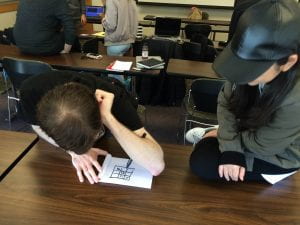
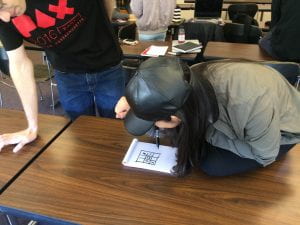
Statement & Iteration:
I was inspired by the concept of the Dada movement that taking out the functionalities of objects and remake them to give new meanings and definitions, such as the readymades, the components were nonfunctional but with combining/modifying it makes a pretty interesting result. Same as that, to applied the similar abstract concept I was thinking of adding/combining two totally different game type/mechanics together, or taking some essential part of rules from each, to complete the appropriation.
The first idea I came out is adding physical elements to a strategic board game. To be more specific, I want to add parameters that were very difficult to measure (like basketball, the real-life physics were considered to be the parameter in this case) to a game that requires a lot of accurate calculation/strategic moves.(like chess)
So I came out with this additional rules, each turn players named a body part to limit the opponent, because I think this not only brings iterations and challenges to both of the players, also changes the game dynamic during gameplay.
So in order to make this more straight forward, I thought I would start with something more simple, such as a “solved game” as a base rule to appropriate on, because I thought adding new rules might add something new to this.
After the first playtest there is only one major issue is that the game is too short to play, so I changed the grid to 9×9 and added new adapted rules to the original tic-tac-toe, where the player can have 1 extra move when the player has 3 marks chained together.
The result turned to be pretty good, players are very creative on the use of mechanics, that it’s really difficult to predict what’s their strategy is because of the ambiguity of names of body parts, which is a very fun aspect of this game, and it’s very fun to watch people play with a lot of physical restrictions to use the marker.
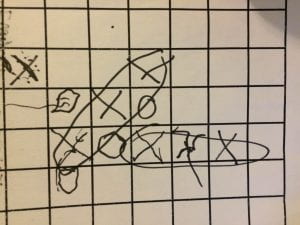
The marks made on the paper, the up-left “X” was marked by the player holding the marker by his legs and finally marked on the wrong grid. (Sorry I didn’t take picture of the final playtest, but it looks pretty much the same as the first playtest posted above.)
monopoly chess
Instructions:
The game is to be played with 2 players and the goal of this game is like the normal chess, to kill the king.
Rules:
1.When each player finish moving his piece, he should draw a movement card.
2.Each player need to draw a battle card before he start kill the enemy piece.
3.Piece can not share the same position unless the cards effect
4.Class system: There is a class system, from high to low is King, Queen Bishop, Knight, Rock, Pawn.
5.When the piece go out of the board, it dead.
6.Multiple battles:When piece fight with multiple enemies, it should fight the lower class piece first, then the higher piece can fight back.
Play-through:
First I want to say Hex is the duel king, she won all the games. Actually, I think this game is very good, after the first text on last week, I adjusted a little bit of the rules to make the game run more reasonable. It is fun when you add random factor in to a logical chess game.
When you play classic sports or games, such as Frisbee or chess, have you ever think about to change the rules, not just play like a traditional game, but add new element in it, when you find a different way to play means more fun than the old thing
Artist’s Statement:
When I decided to create a game based on the appropriate, the first image came in my mind is Marcel Duchamp’s LHOOQ, I think it is a classic example of Dada compare with traditional art. Another huge part of Dada is its collage arts. So I started to think about use this concept, try to design a game that combine lots of elements in to a classic game to make it in classical, like Marcel add the beard on Mona Lisa’s post card.
So, I came up with idea that add “beard” on classical chess, add random factor to make it looks like monopoly. Inspiration for using chess is because I have strong impact from Fluxus. In previous class, one the of the video was talking about two people are playing chess, then the chess board started to move and run away. People already play chess hundreds of years, but never think about to change the rules. So all the cards are related to animations, games and series, such as Yu-GI-OH, Pokémon, dragon ball, these make it looks like there are lots of appropriate elements involve when you play the game.
When I first time tested this game, it was not quite go as I planned, and there was also have problem in multiple battles, so after received serval suggestions, I changed some rules for multiple battles, which makes it more playable in the second test. I think it is quite good this time, and the random factor makes the game more fun than before.
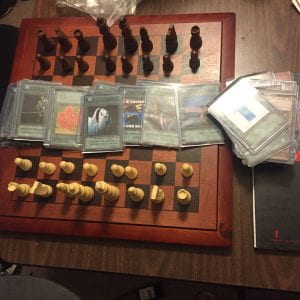
Final Iteration: Work Simulator 2017
You’re trying to get a promotion at work and compete with your coworkers to see who gets promoted first. During your 9 AM-5 PM shift, you try to make a lasting impression with your boss. The game ends when everyone reaches the 8-hour mark, and the player with the most points wins.
Materials:
- Index cards (or small sheets of paper)
- Button pins
- Writing utensil
- D6
Rules:
- Each index card represents a player’s time card.
- Each turn, the player rolls the D6. The number rolled determines how long it took to complete a task. Each number on the die constitutes the number of half-hours the task took to complete.
- Before the turn ends, the user draws a chance card*. Chance cards can grant the user bonus points, add time to the user’s task, or give no additional effects depending on the outcome.
- If the user assists another player, the user gains a token, which can be pinned to their clothing (optional).
- Players can steal tokens from others or take from the pile.
- Once a player hits the 8-hour mark, they are not allowed to take any further turns. Those remaining in the game are not allowed to steal tokens from these players.
*If you run out of chance cards, reshuffle the deck.
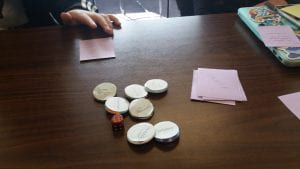
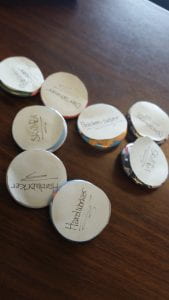
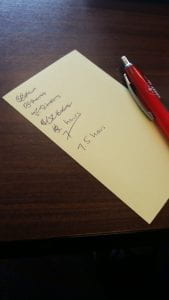
Artist Statement
In the beginning stages, I was a little confused and had trouble grasping a clear concept. I understood the definition, in words, of appropriation, but struggled trying to translate it into a playable game. I was too caught up on aesthetics and didn’t pay enough attention to the meaning of the objects I selected so that I could manipulate them in such a way. Luckily, this is where playtesting comes in, and I am able to make changes based on feedback from others.
In the first iteration of this game, the objective wasn’t very clear, as I was a little unsure of what exactly I wanted to appropriate in order to create this game. Initially, the goal was to finish all of your tasks without going over the allotted time. While this was an okay objective to start out with, there wasn’t much context or motivation to back up the original objective. After playtesting the first iteration and taking feedback into consideration, I was able to recreate a better idea.
After learning about the Dada movements and having prior knowledge of Fluxus and the idea of happenings, I came to appreciate the idea of an object being used in a new way while still being able to portray and capture its original meaning. In the beginning, it was a little difficult for me to grasp this concept, as I was so set on creating a specific game with specific aesthetics.
I incorporated the use of buttons in this piece to call attention to the nature of the workplace. While they were used as a means of racking up points, each token had a character trait inscribed on them, which mirrored the user’s “reputation” with the boss throughout the game. Since the tokens were made of buttons, the users had the option to wear them, which would further emphasize the fact that they were being used as labels. I also incorporated the mechanic of being able to steal from other players to show that what your boss sees isn’t necessarily what actually occurs in the workplace.
After playtesting the final iteration, it was interesting to see how competitive the game became. Players quickly adapted to the idea of the tokens also being used as labels, which made the game much more effective. While I did enjoy Fluxus’s idea of happenings, this piece was more heavily influenced by Dada in a sense that I wanted to call attention to the meaning of labels in the workplace while incorporating everyday items and office supplies.
Overall, I enjoyed reading about Dada and learned that by appropriating objects in this manner, we are able to develop a new perspective despite having a general idea of what an object’s purpose and use is generally for. This is a practice I enjoyed, as it gave a bit of an obstacle to work with, which allowed for more creativity throughout the game design process. I, again, was pleased with the outcome and would greatly enjoy using this method as a means of developing future games and ideas.
Final Appropriation Piece
Rules:
For 4 Players (and 1 moderator)
- A picture is cut up into four pieces. The moderator assigns each player one of these pieces.
- The moderator places one of the pieces face down on the table and ensures that the player has the blindfold held up to their face and is ready. Then, the piece is flipped over and the player has 10 seconds to look at and memorize the image. At this point, the other three players must be facing another direction.
- After the ten seconds are up, the player must then draw out a recreation of what they saw on a piece of paper. Once they are finished, the turn of the next player will begin. This process will continue through the players one by one.
- After all players have seen and drawn their piece, they must put together their pieces and attempt to figure out what the original image was. If their guess is correct, they win.
Documentation:
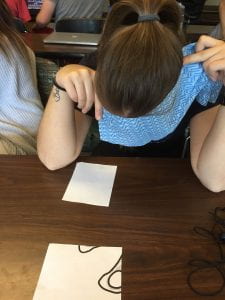
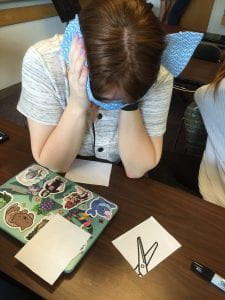
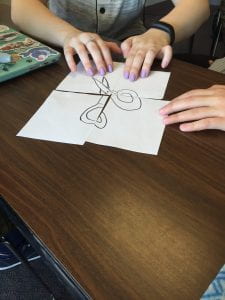
Artist’s Statement:
When we were first assigned this piece, I immediately thought of the aspect of Dadaism where something practical is altered so that it no longer functions for its original purpose. Based off of the pieces shown in the book and some of the works that we discussed in class, this seemed to be a reoccurring theme throughout the movement and I wanted to do something in a similar vein.
With this in mind, I started to think of things that could be changed so that they would not do what they were made to do. This reminded me of a set of wash clothes that I had bought from Target a few weeks prior. I had tried to use them while cleaning my room once and found that they were absolutely terrible – if anything, they made my room messier by not absorbing anything and spreading it around instead. In a sense, the manufacturers of the wash cloth had already done my work for me. They made an object that was useless for accomplishing its original purpose.
As I was playing around with the wash cloth to see what kinds of things I could do with it, I noticed that the fabric was somewhat porous (presumably so that it would be able to soak up a mess) and if you stretched it out and looked at it from the right distance, you could see through it. It wasn’t perfectly transparent, though, so I thought that I could use it as a blindfold of sorts.
This set the goal of my game into place. To be able to decipher an image while looking through the cloth. I experimented with looking at different images while blindfolded and noted that simple, basic outlines were the best bet. But it wasn’t much of a game to simply look at a picture through a cloth and then say what it is, so I split the image into four parts to add some challenge to the game. Players would have to cooperate in order to get the whole picture.
That did, of course, add the drawing element to the game. Unless everyone had photographic memory and could perfectly describe what they had seen, they would needed to be able to draw their section. Unfortunately, the clothes weren’t long enough to be wrapped around a head and tied like a proper blindfold, so I simply had players look at the image through the cloth, then draw it afterwards. I placed a time limit on how long they could look at the image for because I noticed that, if you got skilled at stretching the cloth just right, it wasn’t much of a challenge to see through it. I gave the players 10 seconds to look at the image so that, hopefully, they wouldn’t have the time to get accustomed to using the cloth.
The actual gameplay is quick, fun, and confusing at times, which was great because I felt like those qualities kind of captured the essence of Dada.
Appropriation Project – Serpent To Ride
As mentioned in my earlier post, for my Appropriation Game, I wanted to take a traditional game and make something new, that required a totally different skill set and mindset, and adding at most only one or two extra materials.
Some appropriations that influenced me were Yoko Ono’s White Chess, the concept of Readymades, and examples in class such as Human Go. By coloring the whole chess set white, Yoko Ono shows that both factions are essentially the same, and on the same team, and that they shouldn’t be fighting. The main mechanic of this game is remembering where your pieces are, and this makes chess both a game of mental planning, and a memory game, which adds another difficult layer on top of an already complicated game. While I liked this idea of adding complexity, I wanted to see how far I could stretch the boundaries of a game instead of seeing the results of one simple change, because I thought it would be more difficult, interesting, and informative.
The concept of Readymades and Fluxkits showed that you can do interesting things and create works of art by just using the objects that you had on hand. You have to fully examine whatever object you would be using, determine its affordances, and choose the best way to utilize the object, whether it be for display or some other purpose. Fluxkits used common household objects such as matchsticks and film reels for artistic use. And certain Readymades were displayed as pieces of art, including Marcel Duchamp’s Bicycle Wheel, Fountain, and Bottle Rack. So, I wanted to follow in the footsteps of the Dadaists and use an unconventional household object in my game. I wanted something that could be used instead of trains as pieces for the players on the Ticket to Ride board, and paperclips stood out to me as a simple way to show the locations and paths of each player, and they were just wide enough to fit on the Ticket train pathways.
Some of the Appropriation examples in class were influential to my game. Human Go, a variant of Go that is life-sized and played with humans as playing pieces, was something that showed me how playing pieces can really change the game. It’s harder to see the whole board the larger it is, and the larger the board, the slower the game goes. These are all results of the size of the playing pieces. I wanted a different experience than Ticket to Ride, so I shied away from the typical ‘placing trains down to complete routes’. Instead, I decided to use the routes as pathways you could travel on, and your player would not be in any one location permanently.
Inherently, this lent itself to a game similar to Tron or Snake, where your tail gets longer and longer, and you have to avoid all walls while trapping the other players. For a full description, see my previous post here: https://experimentalgamedesign.sites.northeastern.edu/2016/10/12/appropriation-playtest-serpent-to-ride/
But after my second playtest, I decided to change a few things. The motive behind some of the actions was questionable at best. For example, completing routes would move your snake out of a dangerous situation, moving potentially across the whole map, but your tail would get longer. Having a longer tail would make it easier to trap others, but also you have less area to move.
My playtesters said that they would like it better if there was a more concrete win condition, because although adding more paperclips makes the game eventually get to an end state, it was particularly difficult to actually trap players. And it was especially frustrating when a player got eliminated early and had to wait for the next game, unlike the traditional German game style that Ticket to Ride is (a game in which everyone is in it until the end).
So, my first change was to make this game more interactive, which meant drawing a hand of 3 color cards, and after you move, you replace on of the visible color cards with one from your hand, and redraw. The visible color cards represent pathways that no player can travel on. This way, it provides player input and strategy about which colors to hold, and which colors to use to trap other players, instead of it being random.
But, eventually I came to terms that the German style might be better, but more playtesting would be necessary.
This new style has the same basic play as the old version of the game, except there are two major changes.
1) The winner is the first player to get to four completed routes. Each player starts with 3 face-down routes, and whenever they complete one, they get another one face-down. The rules entailing route completion still applies (instead of moving up to 6 train spaces on your turn, you can turn a route face up, provided you are on one of the cities, and if there is a clear, unobstructed path from your city to the destination, then you move your snake along that path and add 5 paperclips to your tail). As your snake grows, there is less space to move, making it harder for you to get your last couple routes.
2) I removed the ‘player death’ aspect of the game. Players cannot die. Instead, if they cannot move, they just do not move. Thus, blocking players off is still relevant because the more freedom you have to move, the more likely you are to complete your routes.
Along with these changes, I’m still keeping my first change as it does allow more player interaction. This new version still keeps with the themes that I discussed earlier: creating a new experience by changing something in an existing game, using readymade objects as playing pieces, and using the playing pieces’ affordances in a well thought out way. Although it does make the game more like Ticket to Ride by focusing on route completion, my game goes about it in a different way, allowing the board and the blocked spaces to be more fluid to provide a unique experience.
Playtesting this game in class went well, and the players liked it and thought it was fun. We started with 5 paperclips each in a 3 player game, and we went to 4 routes completed. Each player started with 3 routes, and got one whenever they finished one. The colors and movement were fine, and playing colors to block others off was pretty common, and it became known that ending on a location that had many paths out of it was good because of this. Players were much more willing to block themselves off for a turn or two, just to get to the destination they wanted. I think this tradeoff is good, as it gives each player more options. I think that there are still imperfections with the game, but I am pleased with the result of this project.
UNO Holdem (Final)
Instructions:
The game is to be played with 3+ players
The goal of this game is to win the most amount of chips from other players.
- Each player is dealt 2 cards and 3 Cheetos as chips
- Place 3 cards facing up in the center of the table (these are called community cards)
- Assign a player to begin calling stakes (in number of Cheetos betted)
- Each player subsequently must either call, raise or fold
- Deal an extra card once a round of calling has been ended
- Repeat steps 4 and 5 one more time
- All players are to use their functional cards if applicable
- Remaining players show cards to determine the winner, whom takes all betted chips
The winner is determined by possessing the better hand, the rules are:
- High > Low
- Same suit > varying suits
- 3 consecutive numbers > Pair
- 3 of the same > 3 consecutive numbers
- If +2 or +4 is shown, add the respective number of cards to the community deck
- If color changing card is shown, the player may switch any card for a card in the deck
- Skip and reverse cards are not available
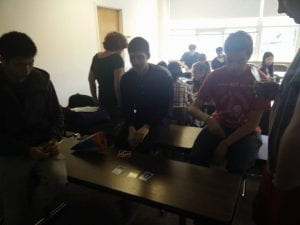

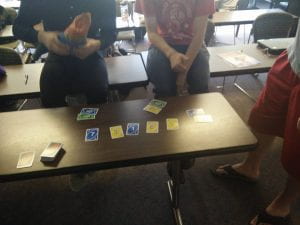
Ideation
I have always been an avid card game enthusiast, whether that is Poker, UNO or almost any variation of card games that involves a bit of strategy and reading the group. To me, I find it very enjoyable as it’s not strictly relied on the mastery of a skill such as professional sports, and it’s also not too random as the likes of Rock, Paper, Scissors or flipping a coin.
However, creating this game was initially very difficult simply because my mind was going through too many possible card games and I didn’t have a good starting point. Finally, I decided to reverse-engineer the ideation process and start with a theme and message instead of starting with a game to appropriate. I had a lot of fun playing around with the idea of Fluxus from my Score assignment and wanted an element of that, whilst also incorporating some of my understanding of Dada. I arrived at the conclusion that I was certain I wanted to create a multiplayer game that had both an element of skill and luck within, which is when 2 of my favorite games came to mind — Texas Holdem and UNO.
Inspiration
One of the reasons I chose this game for my final iteration is because I was very excited about the changes in the meaning. I saw this a perfect fit with the material I learned from Dada, where one is encouraged to create new meanings by presenting something to people in a new perspective. In this instance, I have turned Texas Holdem, a game known for being very strategic, calculative and detail-oriented into an unpredictable one that relies greatly on instinct. As a Business student, this is even more interesting, as I am trained to look for patterns and reduce risk, and now I am forced to embrace the unknown. In this game, neither the number of players or even number of cards is known, with the latter also being potentially subject to change during the game.
Another concept that I incorporated was the “happening” from the Fluxus. After all the cards are dealt, any wild cards held by the players (if any) directly changes the deck either by switching out cards in the community deck and players’ hands, or adding cards to the community deck. This creates a great element of surprise that cannot be planned. In regular Texas Holdem, a player knows that they have 2 cards in their hands and that they will be given 5 cards in the community to work with; whereas in this case, one could have both their cards switched out with 9 cards to play with. The unpredictability is also increased with a larger number of players.
Play-testing
Play-testing this game was very fun, with a total of 4 players and 2 rounds, there was a round with multiple wild cards and a community deck size of 9, and another round where no wild cards were shown and maintained the default size of 5. My classmates seemed to respond positively and I was very happy with the game overall.
Artwork #2- Trash Hoops
Objective: To get the most points by scoring balls of used paper in the recycle bin.
Rules:
Scoring from the first floor stairs is 1 point. 2 points from the second floor, and 3 points from the 3rd floor. If a shot goes in the trash, its -1 point.
Each player gets 5 shots.
The players alternate turns between shots. The player with the most points by the end wins.
Artist Statement:
I had trouble coming up with ideas for a game using appropriated material. I wasn’t sure what to make, and what to transform. The idea came about when I was leaving class. I walked by and saw the trash cans, and the way they were set up reminded me of basketball hoops. This made me think of transforming people’s views on trash and recycling through a game. Learning about the Fluxus movement, and how they wanted to separate boundaries between life and art, my game is my attempt.
Inspiration for using the staircase came from 3 semesters ago. I got to witness Celia Pearce’s class drop mini beanie bags from the 2nd story rails while people with boxes on their heads ran along the first floor randomly trying to catch them. The use of heights, a staircase, used for connecting different levels of structure would be symbolic of my scoring system. I think my piece embodies more Fluxus than Dada since it available to the masses. Everyday people recycle paper and plastics, and throw away trash. Yet, people still remain ignorant to the fact that they have a part in hurting the environment whenever they throw recyclables in the trash. This way, by attempting to break the barrier of art and everyday life, people can educate themselves while having fun. This will give the player, the control of shaping the piece. That being what they choose to shoot in the recycling bin, or the trash can. This pulls more from Fluxus, since it is a process which is for creating rather having an end product, which is influenced by the ideologies of John Cage. The end product would be the outcome of the environment.
My first iteration of this, I hadn’t thought of the recycling bin. I had just seen the trash cans, and they looked perfect for the game I was going to make. After a few playtests, I realized it had no meaning to me other than basketball with paper. I then saw the recycling bin, and thought that I could address the differences between the two of them, using my game. Since its more common for people throw away anything into the trash, I would make that a consequence. This way people would become more aware of recycling and their focus would adjust accordingly.

The Goals

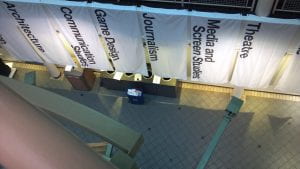
3rd floor

Winner
collage heart (final)
Instructions:
To be done with two (or more) players.
Preferably to be done on a digital canvas such as Google Drive, so that players may use their own saved files. May also be done on a single digital device.
Select a concept.
Go around until every person has placed a found image that strikes them as relevant upon the canvas. They may overlap, arrange, and rearrange the images as they wish, so long as it is their turn.
Go around again until every person has placed a found phrase that strikes them as relevant upon the canvas.
Alternate until you feel the canvas is complete.
Play-throughs:
(Warning for gory, bloody stuff in the first image!)
I wanted to try out the game with more than one person, so during the class period, I tested it out again. This time we settled on the concept “horror” in celebration of the current month. I started off with a cute little ghost, but very quickly things escalated, which was actually surprisingly fun. The end result is a little horrifying, but that was the whole point, in the end.
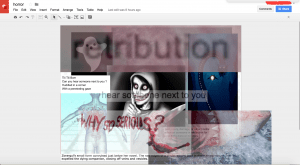 (recent playthrough)
(recent playthrough)
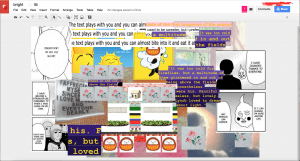 (original playtest)
(original playtest)
Artist’s Statement:
While the style I wanted for this piece did not quite match up with the underlying messages and concepts behind Dada, I loved the aesthetic of it. Especially the collages of images and words removed from their context, such as Raoul Hausmann’s “ABCD”/”Portrait de ‘artiste” or Hans Arp’s “Untitled (Abstract Composition)” or others. These collage pieces just seemed like they would be so fun to make. And so, I made that one of the bases of my piece: to actually go through that process of creating a collage.
As might be obvious from my last piece, I am really interested in exploring interactions between different people in a creation process. I also love seeing how different people perceive what should be the “same” concept or idea. And so, I thought, why not have people work on a themed collage together? At first, I wanted it to be entirely physical – I wanted to be able to cut out images and phrases from magazines and books. However, there would have been some level of difficulty in staying consistent with the theme and might have limited people’s visions. (Besides, I have rarely been able to actually go through with cutting up a book.) But then I remembered – it’s 2016. We’ve got the internet, and boy howdy does it have a lot of stuff!
So, I came up with a piece that asks for the participants to use any image or words that they did not come up with specifically for this piece to illustrate some concept. Using the internet (and sometimes weird screenshots from a long time ago, or words from a short story you had almost forgotten about, or even screenshots of a salient portion of the current canvas) would result in what I hoped would be a very varied, fun experience.
I think it is in this back and forth growth and interaction that I also incorporate some ideas from Fluxus. Art is experience and life, and life is constantly changing. With this piece, the participants are constantly giving and receiving a stream of information from the other player(s). Just like regular communication, you give your own interpretation of a subject and wait to interpret someone else’s. People also feed off of each other’s innovations. For example, when I took a screenshot of a word in the “horror” piece, on Ilayda’s next turn, she did too. Incorporating transparency into the images used was also a fun twist that made for a really interesting final result. I like how fluid this process inherently is – how far from static it has the potential to be.
I really like intimacy in creation, but for this piece, the intimacy depends on the number of participants involved. The more people there are, the less individual connection you get with them, of course. But, either way, I want it to be a fun – or interesting, at least – experience!